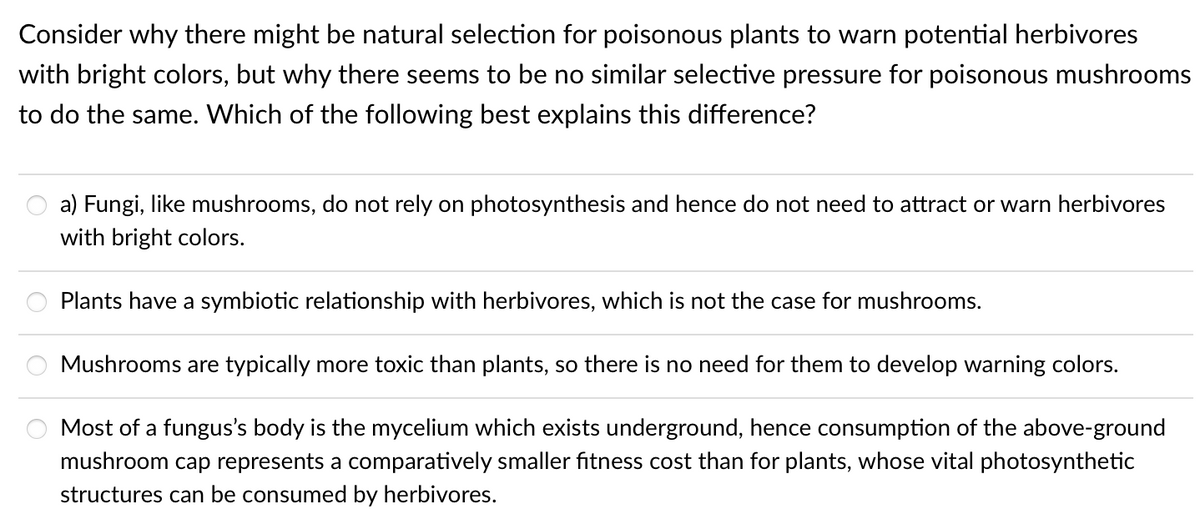Consider why there might be natural selection for poisonous plants to warn potential herbivores with bright colors, but why there seems to be no similar selective pressure for poisonous mushrooms to do the same. Which of the following best explains this difference? Tooo a) Fungi, like mushrooms, do not rely on photosynthesis and hence do not need to attract or warn herbivores with bright colors. Plants have a symbiotic relationship with herbivores, which is not the case for mushrooms. Mushrooms are typically more toxic than plants, so there is no need for them to develop warning colors. Most of a fungus's body is the mycelium which exists underground, hence consumption of the above-ground mushroom cap represents a comparatively smaller fitness cost than for plants, whose vital photosynthetic structures can be consumed by herbivores.
Consider why there might be natural selection for poisonous plants to warn potential herbivores with bright colors, but why there seems to be no similar selective pressure for poisonous mushrooms to do the same. Which of the following best explains this difference? Tooo a) Fungi, like mushrooms, do not rely on photosynthesis and hence do not need to attract or warn herbivores with bright colors. Plants have a symbiotic relationship with herbivores, which is not the case for mushrooms. Mushrooms are typically more toxic than plants, so there is no need for them to develop warning colors. Most of a fungus's body is the mycelium which exists underground, hence consumption of the above-ground mushroom cap represents a comparatively smaller fitness cost than for plants, whose vital photosynthetic structures can be consumed by herbivores.
Biology: The Dynamic Science (MindTap Course List)
4th Edition
ISBN:9781305389892
Author:Peter J. Russell, Paul E. Hertz, Beverly McMillan
Publisher:Peter J. Russell, Paul E. Hertz, Beverly McMillan
Chapter53: Population Interactions And Community Ecology
Section: Chapter Questions
Problem 1ITD
Related questions
Question

Transcribed Image Text:Consider why there might be natural selection for poisonous plants to warn potential herbivores
with bright colors, but why there seems to be no similar selective pressure for poisonous mushrooms
to do the same. Which of the following best explains this difference?
a) Fungi, like mushrooms, do not rely on photosynthesis and hence do not need to attract or warn herbivores
with bright colors.
Plants have a symbiotic relationship with herbivores, which is not the case for mushrooms.
Mushrooms are typically more toxic than plants, so there is no need for them to develop warning colors.
Most of a fungus's body is the mycelium which exists underground, hence consumption of the above-ground
mushroom cap represents a comparatively smaller fitness cost than for plants, whose vital photosynthetic
structures can be consumed by herbivores.
Expert Solution
This question has been solved!
Explore an expertly crafted, step-by-step solution for a thorough understanding of key concepts.
This is a popular solution!
Trending now
This is a popular solution!
Step by step
Solved in 3 steps

Knowledge Booster
Learn more about
Need a deep-dive on the concept behind this application? Look no further. Learn more about this topic, biology and related others by exploring similar questions and additional content below.Recommended textbooks for you

Biology: The Dynamic Science (MindTap Course List)
Biology
ISBN:
9781305389892
Author:
Peter J. Russell, Paul E. Hertz, Beverly McMillan
Publisher:
Cengage Learning

Biology (MindTap Course List)
Biology
ISBN:
9781337392938
Author:
Eldra Solomon, Charles Martin, Diana W. Martin, Linda R. Berg
Publisher:
Cengage Learning

Biology: The Dynamic Science (MindTap Course List)
Biology
ISBN:
9781305389892
Author:
Peter J. Russell, Paul E. Hertz, Beverly McMillan
Publisher:
Cengage Learning

Biology (MindTap Course List)
Biology
ISBN:
9781337392938
Author:
Eldra Solomon, Charles Martin, Diana W. Martin, Linda R. Berg
Publisher:
Cengage Learning